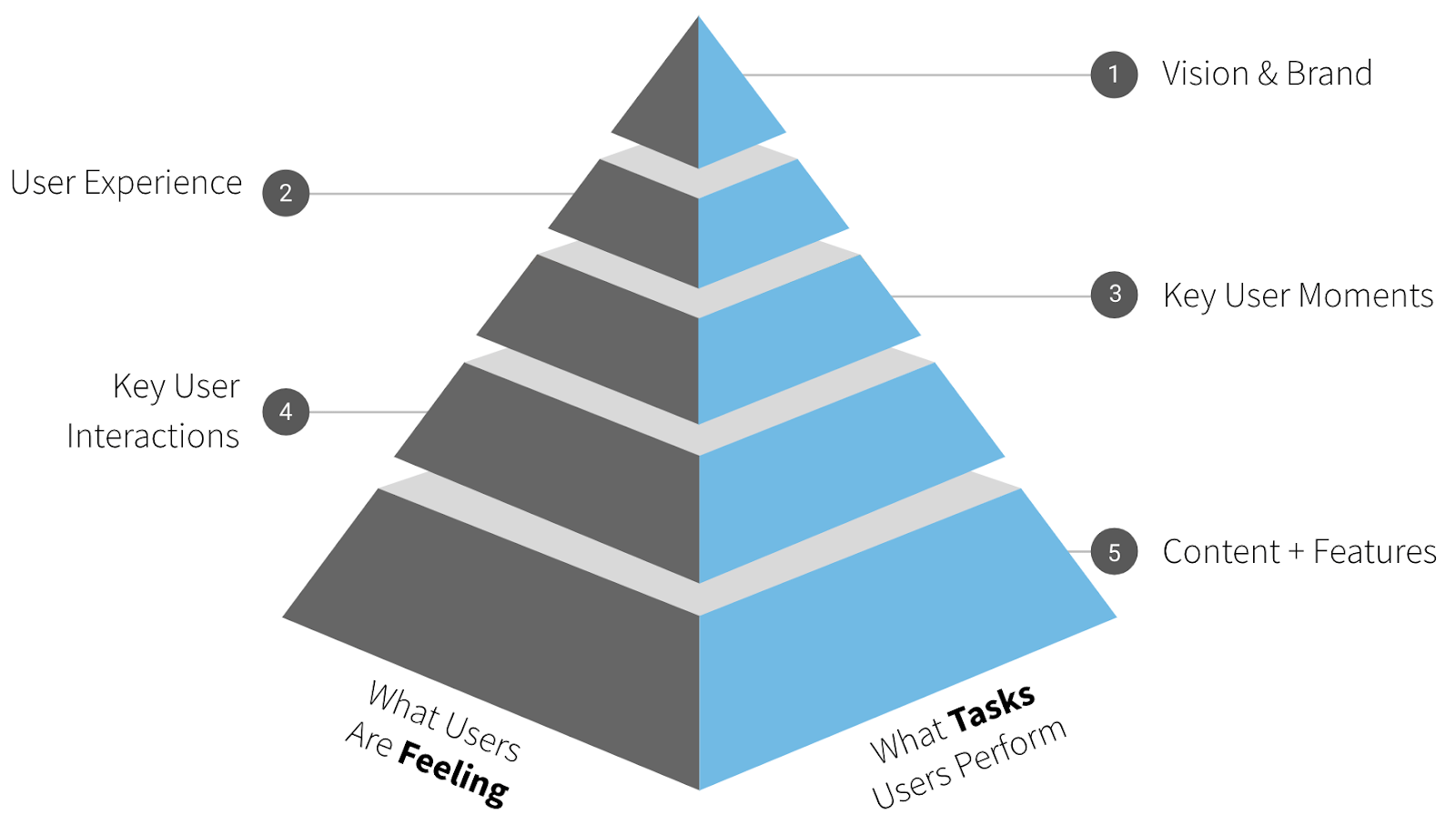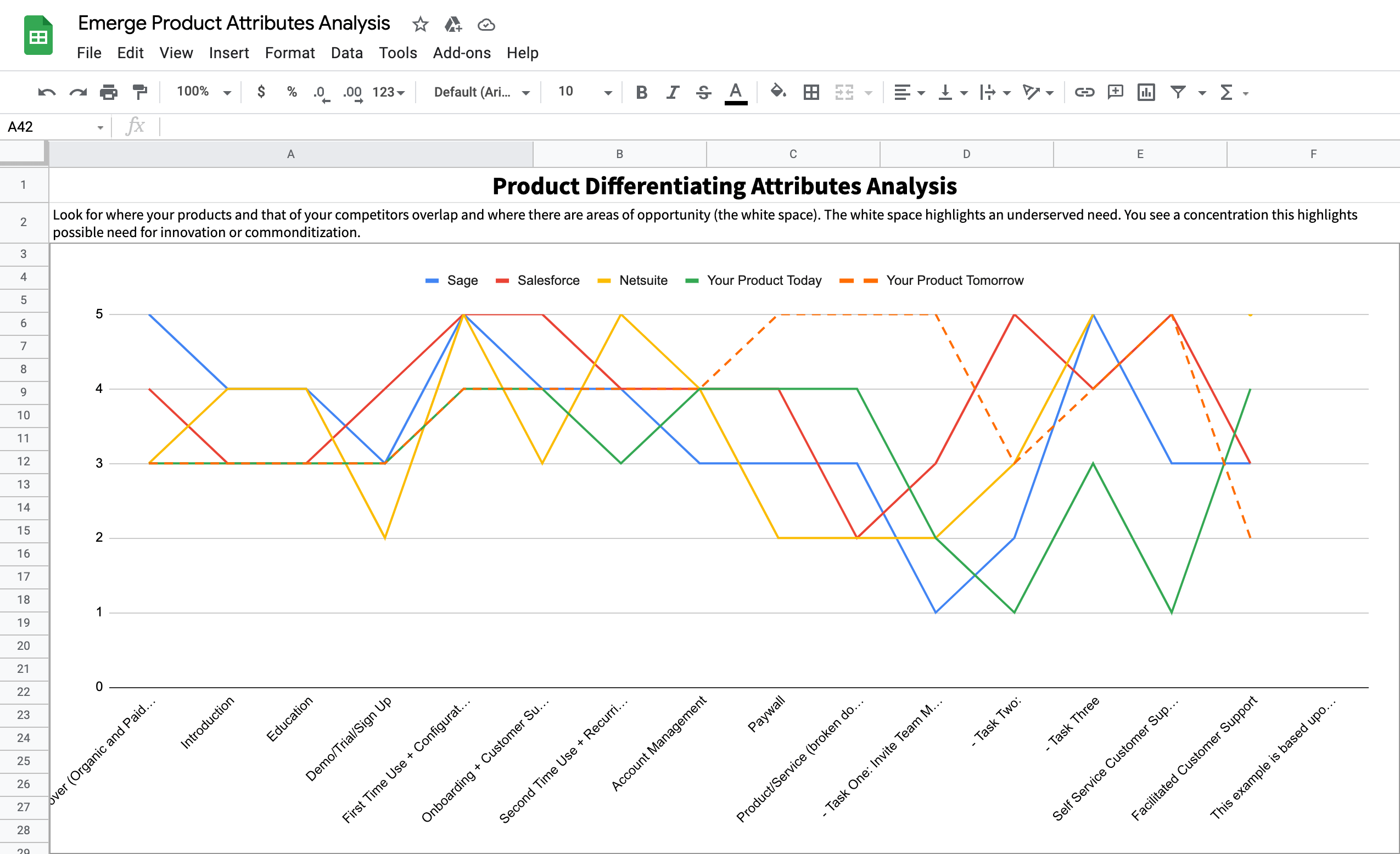
Differentiated by Design – The Composition of a Strategically Grounded Digital Product
- Product Design /
- Product Leadership /
- Product Strategy /
Product differentiation is essential for creating effective products that address the unmet needs of customers and users. To achieve this, it’s important to have a deep understanding of the challenges they face and to solve those challenges in a unique, relevant, and sustainable way that sets you apart from your competition. As a product leader, your ultimate goal should be to differentiate your product and make it stand out in a crowded marketplace.
True differentiation is an essential component of product strategy. So how should you approach product or service differentiation that facilitates achieving that ultimate goal? In this article, we will break down what product differentiation is, the types of differentiation, and a systematic approach for product leaders to identify where to focus in relation to the competition. We will also share a proven approach to differentiation that will help you create a competitive advantage and a thriving business.
What is Product Differentiation?
Product differentiation is focused on distinguishing your offering from others that are competing for the same core customers. This includes differentiation of the product from competing brands.
Products can be differentiated by how they meet a psychological or functional need of the user. Your audience may have expressed a problem they are having, or they may be unaware of an unmet need.
To set your product apart from the crowd, it’s helpful to consider two areas to identify the most significant opportunity. The first is time to value. It is a simple concept, really. How quickly can a customer see the value in a product or service? Understanding the time to value provides an opportunity to maximize the impact delivered to customers, creating a sustainable competitive advantage and driving long-term growth. If a product or service can quickly demonstrate its value to the customer, it can tip the scales in your favor and win over customers and even disrupt an entire industry.
Some products and services have a naturally short time to value. For example, a ride-sharing app like Uber or Lyft can demonstrate its value almost instantly. The customer sees the driver arrive, gets in the car, and is whisked away to their destination. The value is clear and immediate.
However, other products and services have a longer time to value. These might be more complex products or services or might require a certain amount of user education. In these cases, it is important for the company to find ways to accelerate the time to value with continuous reinforcement. This might involve offering tutorials or demos or providing a streamlined onboarding process.
The second consideration is the competitive landscape, which includes other options your target audience may be evaluating. The four types of competition to consider when distinguishing your product or service are:
- Products that are nearly indistinguishable from your product or service.
- Similar products that compete for wallet share but aren’t perfect substitutes for your offering.
- Products that address and satisfy the same core psychological (emotional) need that your product or service provides but are functionally unique.
- Products that compete for the same broad, finite resources (i.e., money, time, attention, etc.).
Advantages of Digital Product Differentiation
While product differentiation comes in many different forms, it is all built on having a clear picture of who your core customers are and are not. It’s about understanding the emotional and functional needs of your customers and users. This distinction is important as each defines areas of opportunity and friction that need to be addressed.
By focusing on your core customer, you can gather actionable insights into their articulated and unarticulated needs. It unveils the impact of the challenges your product or service needs to solve. With this in-depth understanding, the competitive landscape takes shape.
Some benefits of product differentiation include:
- Capturing the attention of your prospective customers: Product differentiation helps your digital product stand out from the crowd, making it more likely that prospective customers will take notice of it.
- Demonstrating the superior value of your product: By highlighting the unique features and benefits of your digital product, product differentiation can help communicate its value proposition to potential customers, making it more likely that they will choose your product over competitors.
- Increasing customer/user acquisition and retention: Product differentiation can help attract new customers to your digital product and increase customer retention by offering unique features and benefits that are not available with other products.
- Taking the focus away from being only price-driven: By highlighting the unique features and benefits of your digital product, product differentiation can help shift the focus away from price, allowing your product to compete on value rather than just cost.
- Providing a positive and more memorable customer experience: Digital products that are differentiated can create a positive and memorable customer experience, which can lead to greater customer loyalty and word-of-mouth recommendations.
- Delivering a more targeted and improved solution over the competition: By understanding the unique needs and preferences of your target audience, product differentiation can help you deliver a more targeted and improved solution that meets their specific needs.
- Focusing innovation on the value exchange, not features: Product differentiation can help shift the focus from adding features to creating value, by focusing on what sets your product apart and delivering that value to your customers.
When executed effectively, product differentiation helps to align your people, processes, systems, and resources to focus on the actions that set you apart. By aligning your resources and processes around your unique value proposition, product differentiation can help create a cohesive strategy that supports your differentiation efforts and helps you stand out from the competition.
Data-Driven Product Differentiation
Following are several common misconceptions about product differentiation:
- That you have to find a proprietary element that no one else has ever consider for your customer.
- That differentiation is a messaging strategy driven by marketing.
- That product differentiation is completely based on a perception that can be shifted by a value proposition, packaging, or pricing.
None of these alone are true product differentiation.
Product differentiation is a business strategy on how to help you will deliver your product in a unique, relevant, and sustainable way. This means we need to move away from seeking silver bullets, and focus on the attributes that cumulatively create a distinct advantage for your product or service. What friction points are you resolving in a valuable way for your target audience? What benefits are unique to your solution? What is the impact of those benefits on the right audience?
In Marty Cagan’s book ‘Inspired,” he states that “Just because we’ve invested the time and effort to create a robust product does not mean anyone will want to buy it. So, in the product world, we strive to achieve product/market fit. This is the smallest possible actual product that meets the needs of a specific market of customers. Marc Andreessen is credited with popularizing this all‐important concept.”
Identifying Product Differentiation Attributes
Before we dive into a systematic approach to product differentiation let’s first look at the composition of a strategically designed product.

As you develop or refine your existing strategy for your digital product or service, it is essential to examine how everything is interconnected. Before you are able to identify attributes that you want to focus on, you must first have a clear understanding of the key moments where your customers and users are engaged. Through this lens, you are able to identify the interactions, features, and content associated with those moments. Each moment creates an opportunity for definable attributes that can be leveraged to differentiate your product. Remember that people’s attitudes drive their behavior, and ultimately, the results.
There are a multitude of different types of attributes you may explore and assess. Users articulated and unarticulated needs that are revealed, and the competitive landscape may include:
- Aesthetics
- Availability (convenience)
- Complexity
- Ease of use
- Emotional needs (i.e. status, community, etc)
- Features and/or Content
- Integration and automation of one or more elements
- Software Localization
- Niche consumer/user focus (specialization)
- Price and terms
- Quality
- Reliability
- Responsiveness
- Security and/or regulatory compliance
- Time to completion of a task
Cumulatively, these attributes should be focused on how the product or service you deliver is better than any competitor and potential substitute. It brings focus to the relationship between providing a great customer experience, and the problem the product or service solves. By focusing on the appropriate attributes, you can identify how you can differentiate your product and create tangible value.
A Systematic Approach to Product Differentiation
In the book ‘3HAG Way – The Strategic Execution System that ensures your strategy is not a Wild-Ass-Guess,’ Shannon Susko takes a systematic approach to the challenge of differentiation through defining attributes.
A deep understanding and evaluation of both your target market and the competitive landscape are critical because it helps you understand which attributes may have an impact on your business and your product. The goal is to define the attributes that will inform your strategy and establish your product in a unique and valuable position relative to the competition. This does not distill down to one thing, but selecting the 3-5 most powerful differentiation attributes to focus on. Those that are interconnected and increase the strength of your product’s market fit.
In the article ‘Taking Your Digital Product Strategy from Vision to Execution’ I talked about the five core elements of great product strategies. This process should be performed through the lens of diagnosing and understanding the scope of the challenge you are looking to solve.
This provides invaluable context for what it will take to realize your goal and the long-term vision of your product or service. It is during this step that you are diagnosing and gaining a deeper understanding of the challenge and separate between symptomatic issues and the root causes.
This allows you to break down the larger challenge into smaller manageable, specific, and actionable issues that you will need to focus on solving. This can help you prioritize the moments as discussed above and look at what attributes have the most potential to impact the value and differentiate your product.
Product Attributes Framework

The power of using an attributes framework is that it gives you and your team a high-level and holistic view of exactly how your product or service meets the needs of your target core customer and users. It also shows you in a clear way why one differentiation isn’t enough. It leaves you vulnerable to the competition and abates any progress, returning you to the point of needing to differentiate repeatedly. In this scenario, you will not be able to establish enough traction in the market to sustain continuous growth before a substitute comes along.
We’ll now use the Attributes Framework to see where the opportunity space is in the market. What we’re looking for are areas the customer and users are either being underserved or areas where there is a significant opportunity for innovation based on actionable insights.
Expect that you will go through this process analysis multiple times as it uncovers new insights, and drives deeply meaningful discussions with the team about how to keep or move your product into the white space– the unique, relevant, and sustainable place in the market that will create value.
This is one of our favorite tools at EMERGE. The one that creates incredible “A-Ha!” moments when helping product leaders define and deliver great digital experiences and products.
Here’s a step-by-step breakdown of how you can apply this approach with your team.
- Break your product team into groups of three to four people.
- Have each participant read this article for context and then download a copy of the ‘Emerge Product Attributes Analysis’ tool to collaborate together.
- Have each group discuss six to twelve key attributes that are necessary to meet the needs of your customers, and establish or maintain a strong market fit. Fill them in on the left-hand side in the column marked “Product Attributes”.
- As a group, go to the column labeled “Your Product Today” and rank each attribute on a scale of 1 to 5 of how well your product serves each of these attributes– one by one. Be as honest and realistic as possible. You can’t be great at all of them. A quick reminder a great product strategy is not just bringing focus to what you need to do, but also being clear about what you won’t do and why.
- Now identify three to four competitors. Put the name of a competitor (or group) in each of the columns labeled “Competitor or Group #1”, “Competitor or Group #2” and so on. Then do the same ranking for your top three competitors. It’s important to note that you need to decide how you define a competitor. Is it a product that is nearly indistinguishable from yours? Similar products that compete for wallet share, but aren’t perfect substitutes? Or, possibly products that are not directly addressing the same need but are broadly competing for the same resources (ie. money, time, attention, etc).
- Once all the groups have mapped out their Product Attributes Framework, have each group review the ‘Analysis’ tab and look for where your products and that of your competitors overlap and where there are areas of opportunity (the white space). Then bring the groups together and share each of the graphs and how they came up with the results.
- As a group, decide on what the 3-5 core attributes if you focused on would differentiate your product. And then have one team member collate the input into one graph.
- The last step is to have a team discussion based on the white space available, what your product needs to do, and then decide what it should not do. This is your focus. This is your aspiration and begins to frame the hard work ahead to delivering a strategically grounded digital product that is differentiated by design.
For example, at Emerge we use this process to map the attributes that matter most to our core customer ‘Product Leaders’; focusing on strategic leadership, data-driven, and behavioral experience design among others that are key to their success and producing measurable outcomes.
When you’re ranking your product, focus on what your team is great at today, even if you plan to improve your product in the near future. If you don’t work from your current state, defining clearly where you are today, then your ranking is aspirational, and it won’t help you honestly assess and determine your opportunities to differentiate and focus. As mentioned earlier, this will also help you decide where to appropriately allocate time and resources without impeding migration to your ideal future state, ‘Your Product of Tomorrow.’
One common and often important realization that becomes evident through this process is that you may not know as much about your competition as you thought. In the most successful product teams everyone in a leadership role is an expert on the customer and the market. This means setting aside opinions and seeking actionable insights. A great digital product strategy defines the value you will create in a succinct and tangible way; where to focus, why, and what it will take to achieve that value. This empowers your team to focus on the right things and determine how to facilitate the delivery of a great product or service. Shannon cites that you are “creating a unique and valuable position in the marketplace–you’re not competing directly against your competitors. You are competing to be unique in the marketplace.” Being unique in your marketplace requires a sophisticated understanding of what your market and industry looks like.
Our experience at Emerge mirrors that of Shannon’s work in what evolves after completing the first pass through the Attributes Framework. Typically, one of two things happen. One scenario is that you step back, having been able to validate that your product is positioned correctly. It is essential to stay focused on the right things and continue to strengthen our position. The second common scenario is that you step back and realize you’re not where you thought you were or where you want to be. This is the juncture to decide where you really want to be as a company with your product. Now the ‘Your Product of Tomorrow’ column comes into play. Decide how you will serve your core customers and users. It is also important to identify strategic choices where you are willing to set parameters to not engage. This is your ideal future state and where you need to define how you will go to being the very best in the market. This ideal future state is your unique, relevant, and sustainable position that truly differentiates your product or service.
Using Customer Experience Attributes to Drive Digital Product Differentiation
Great product differentiation is rooted in the interaction of your customer, the market, and knowing your competition. To attain, honor, and defend this position requires a thoughtful selection of the attributes that elevate you above the competition in meeting customers’ and users’ needs. The product attributes framework is a systematic way to dig deeper, tapping into the collective insight, expertise, and experiences of your team. It enables you to discover new opportunities. This is not only a component of great product strategies, but of empowering your team to do remarkable things.